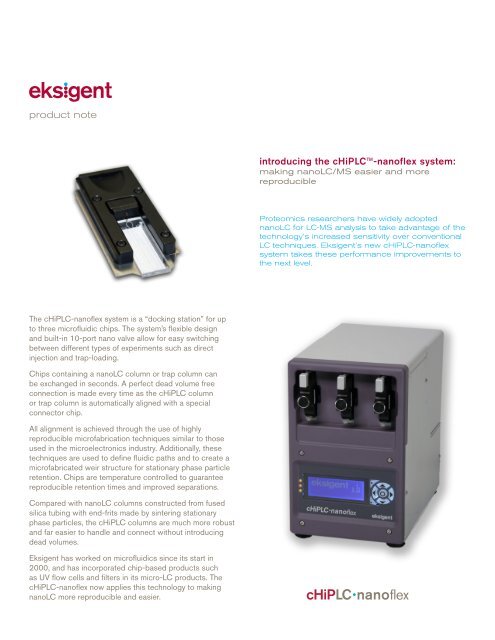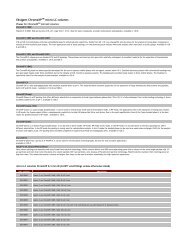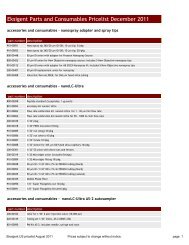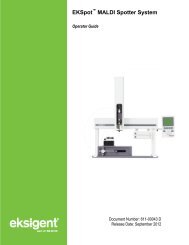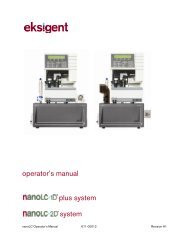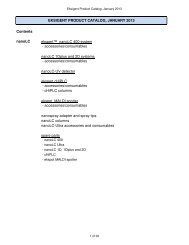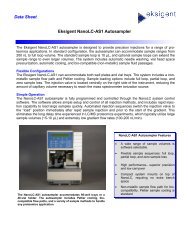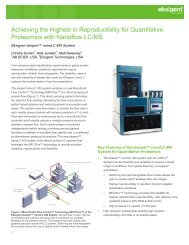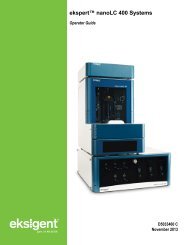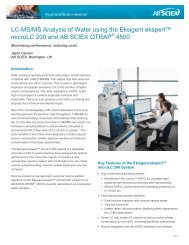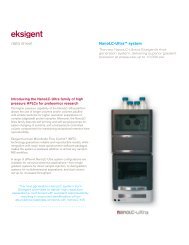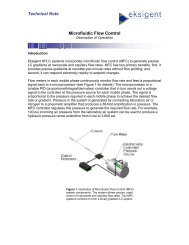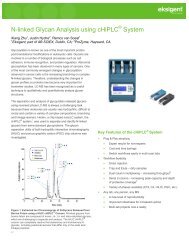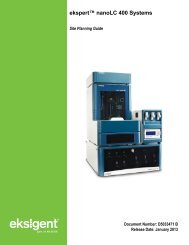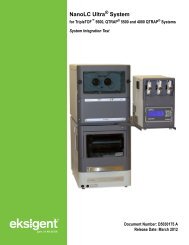cHiPLC-nanoflex system - Eksigent
cHiPLC-nanoflex system - Eksigent
cHiPLC-nanoflex system - Eksigent
- No tags were found...
You also want an ePaper? Increase the reach of your titles
YUMPU automatically turns print PDFs into web optimized ePapers that Google loves.
product noteintroducing the <strong>cHiPLC</strong>-<strong>nanoflex</strong> <strong>system</strong>:making nanoLC/MS easier and morereproducibleProteomics researchers have widely adoptednanoLC for LC-MS analysis to take advantage of thetechnology’s increased sensitivity over conventionalLC techniques. <strong>Eksigent</strong>’s new <strong>cHiPLC</strong>-<strong>nanoflex</strong><strong>system</strong> takes these performance improvements tothe next level.The <strong>cHiPLC</strong>-<strong>nanoflex</strong> <strong>system</strong> is a “docking station” for upto three microfluidic chips. The <strong>system</strong>’s flexible designand built-in 10-port nano valve allow for easy switchingbetween different types of experiments such as directinjection and trap-loading.Chips containing a nanoLC column or trap column canbe exchanged in seconds. A perfect dead volume freeconnection is made every time as the <strong>cHiPLC</strong> columnor trap column is automatically aligned with a specialconnector chip.All alignment is achieved through the use of highlyreproducible microfabrication techniques similar to thoseused in the microelectronics industry. Additionally, thesetechniques are used to define fluidic paths and to create amicrofabricated weir structure for stationary phase particleretention. Chips are temperature controlled to guaranteereproducible retention times and improved separations.Compared with nanoLC columns constructed from fusedsilica tubing with end-frits made by sintering stationaryphase particles, the <strong>cHiPLC</strong> columns are much more robustand far easier to handle and connect without introducingdead volumes.<strong>Eksigent</strong> has worked on microfluidics since its start in2000, and has incorporated chip-based products suchas UV flow cells and filters in its micro-LC products. The<strong>cHiPLC</strong>-<strong>nanoflex</strong> now applies this technology to makingnanoLC more reproducible and easier.<strong>cHiPLC</strong> <strong>nanoflex</strong>
enefits of the <strong>cHiPLC</strong>-<strong>nanoflex</strong> <strong>system</strong>column designSpecial care has been given to the design of both thetrap-chips and analytical column-chips in order to achieveseparations that are equal or better than separationsobtained using packed capillaries (see Figure 1). The useof fused silica allows for cylindrical channels for packingnanoLC columns and traps. Instead of conventionalfrits made out of fused stationary phase particles, our<strong>cHiPLC</strong> columns use a unique weir structure to retain thestationary phase particles in the column. These weirs aremore reproducible to fabricate, while their dead-volume isvirtually zero (~13 pL). In addition, adsorption of samplecomponents that can occur with frit material is not an issuewith these types of structures.identical, and our packing procedure guarantees the bestpossible column-to-column reproducibility in nanoLC(see Figure 2). This is of importance for applications whereretention time stability over longer periods of time and overmultiple columns is important. Examples are the use ofretention time in combination with accurate mass in peptide/protein identification and scheduling MRMs for peptidequantitation in biomarker validation.Relative Abundance15 20 2530Time (min.)Figure 1. Comparison of the separation of a peptidetest mix on a nano <strong>cHiPLC</strong> column and a conventionalnanoLC column. Both columns are 15 cm x 75 µm, andpacked with ChromXP C18-CL 3 µm 300Å. Flowrate is250 nl/min; gradient slope 2% Acetonitrile/min.patented connection <strong>system</strong>Connections to and from each chip are made using apatented connection <strong>system</strong> that can connect up toseven channels to the outside world with a dead volumeof less than 1 nl. The force used to connect the chip ispre-set, so that every time the user exchanges a chip, aleak-free connection is obtained without any required useradjustments.increased column-to-column reproducibilityBesides the ease of replacing a nanoLC column or trap inseconds, the use of our <strong>cHiPLC</strong> columns also increasescolumn-to-column reproducibility. All chips are exactlyFigure 2. Excellent inter-column reproducibility is achievedfor a peptide test mix between three 15 cm x 75 µmnano <strong>cHiPLC</strong> columns packed with ChromXP C18-CL3 µm 300Å. Flowrate is 250 nl/min; gradient slope 2%Acetonitrile/min.simple operationThe <strong>cHiPLC</strong>-<strong>nanoflex</strong> allows for easy switching betweendirect injection, trap-loading and dual column with directinjection experiments. This is achieved through the use ofa fluidic jumper chip, which routes fluid appropriately for thedesired experiment. This jumper chip is as easily changedas the column and trap chips. Figure 3 shows a schematicof the set-up for a trap-loading experiment, showing thejumper, trap and column chip and the 10-port nano valve.nano-spray source compatibilityIn addition, the <strong>cHiPLC</strong>-<strong>nanoflex</strong> can be used in combinationwith all <strong>Eksigent</strong> nanoLC <strong>system</strong>s along with any massspectrometer/nanospray source.
Figure 3. Schematic showing the set-up of the <strong>cHiPLC</strong><strong>nanoflex</strong>for a trap loading experiment.Figure 4. Separation of a BSA digest on a nano <strong>cHiPLC</strong>column of 15 cm x 75 µm, packed with ChromXP C18-CL 3 µm 300Å. Flowrate is 250 nl/min; gradient slope0.5% Acetonitrile/min.ordering informationdescriptionpart number<strong>cHiPLC</strong> <strong>nanoflex</strong> 950-00070Nano <strong>cHiPLC</strong> column 75 μm x 15 cm ChromXP C18-CL 3 μm 120 Å 804-00001Nano <strong>cHiPLC</strong> column 75 μm x 15 cm ChromXP C18-CL 3 μm 300 Å 804-00003Nano <strong>cHiPLC</strong> column 75 μm x 15 cm ChromXP C18-CL 5 μm 120 Å 804-00002Nano <strong>cHiPLC</strong> column 75 μm x 15 cm ChromXP C18-CL 5 μm 300 Å 804-00004Nano <strong>cHiPLC</strong> Trap column 200 μm x 0.5 mm ChromXP C18-CL 3 μm 120 Å 804-00006Nano <strong>cHiPLC</strong> Trap column 200 μm x 0.5 mm ChromXP C18-CL 3 μm 300 Å 804-00008Nano <strong>cHiPLC</strong> Trap column 200 μm x 0.5 mm ChromXP C18-CL 5 μm 120 Å 804-00007Nano <strong>cHiPLC</strong> Trap column 200 μm x 0.5 mm ChromXP C18-CL 5 μm 300 Å 804-00009Direct injection jumper chip 800-00408Trap-elute jumper chip 800-00389Dual column jumper chip 800-00421Chip based particle trap (weir) (between autosampler and <strong>cHiPLC</strong> <strong>nanoflex</strong>) 800-00354
<strong>system</strong> specificationsDimensionsWeightPowerWorkingtemperatureTemperaturecontrol6.5” (17 cm) x 10” (25 cm) x10.5” (26 cm)(Width x Depth x Height)10 lbs (5 kg)100-240 VAC, 50/60 Hz, 2.5 A15 to 30 ºCMaximum pressure 4000 psiValveWetted PartsColumndimensionsTrap columndimensionsInstrument control25 to 60 ºC +/- 0.1 ºC• PAEK 10 port valve• 1/32” connections; 100 μm bore• Port-to-port volume < 25 nl• Max. pressure 5,000 psiPEEK, PAEK, Valcon E, fused silica,tefzel75 μm ID x 15 cm200 μm ID x 0.5 mmAll temperature control is achievedthrough the LCD interface on the<strong>nanoflex</strong>; valve control is achievedthrough the <strong>Eksigent</strong> softwarewhich controls the pump <strong>system</strong>.Valve control can be disabled at the<strong>nanoflex</strong> through the LCD interface.<strong>Eksigent</strong>’s new <strong>cHiPLC</strong>-<strong>nanoflex</strong>, in combinationwith the nanoLC-Ultra <strong>system</strong>, delivers superiorsensitivity, column-to-column reproducibility, andexceptional ease of operation.About <strong>Eksigent</strong> Technologies<strong>Eksigent</strong> is creating new possibilities for life scienceresearch, drug discovery & development, and medicaldevices with its innovative MicroFlow and NanoFlowfluid delivery <strong>system</strong>s.<strong>Eksigent</strong>’s LC <strong>system</strong>s deliver dramatic increases in analysisspeed, throughput, and sensitivity. <strong>Eksigent</strong>’s drug delivery<strong>system</strong>s bring new levels of precision to portable drugdelivery.Today, leading research, pharmaceutical, and biotechnologyfirms around the world use <strong>Eksigent</strong>’s innovative solutions.headquarters5875 arnold roaddublin, california 94568tel: 925 560 2600fax: 925 560 2700email: info@eksigent.comwebsite: www.eksigent.com© 2009 <strong>Eksigent</strong> Technologies. All rights reserved. Information subject to change without notice.<strong>Eksigent</strong> is a registered trademark of <strong>Eksigent</strong> Technologies. NanoLC,CHiPL, and MicroFlow aretrademarks of <strong>Eksigent</strong> Technologies. All other trademarks are property of their respective owners.Patents pending worldwide. Printed in the USA. <strong>cHiPLC</strong>Nano-PN-0109-1000


